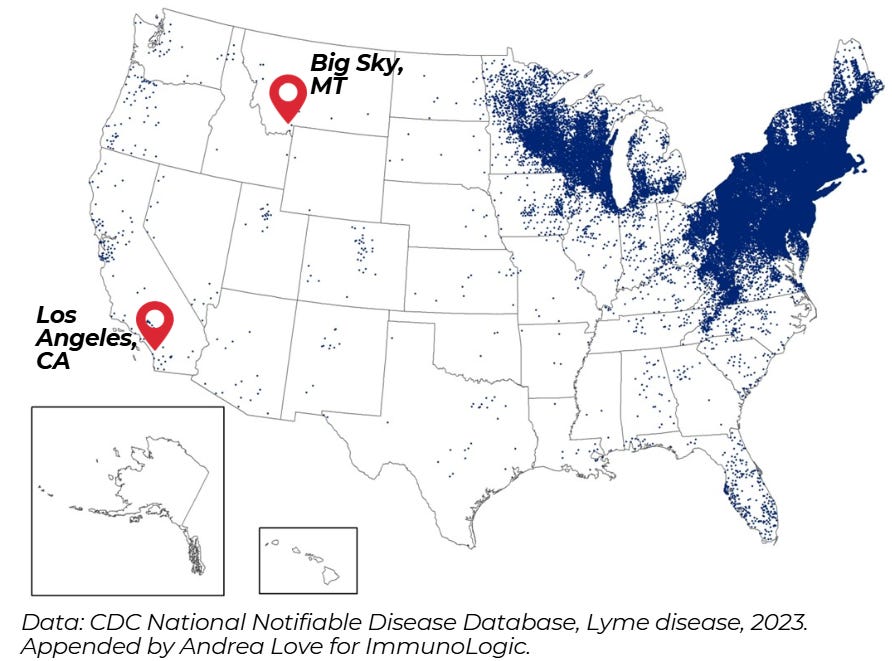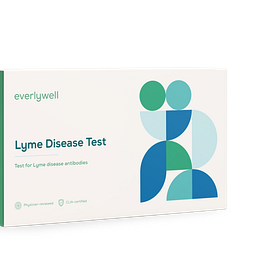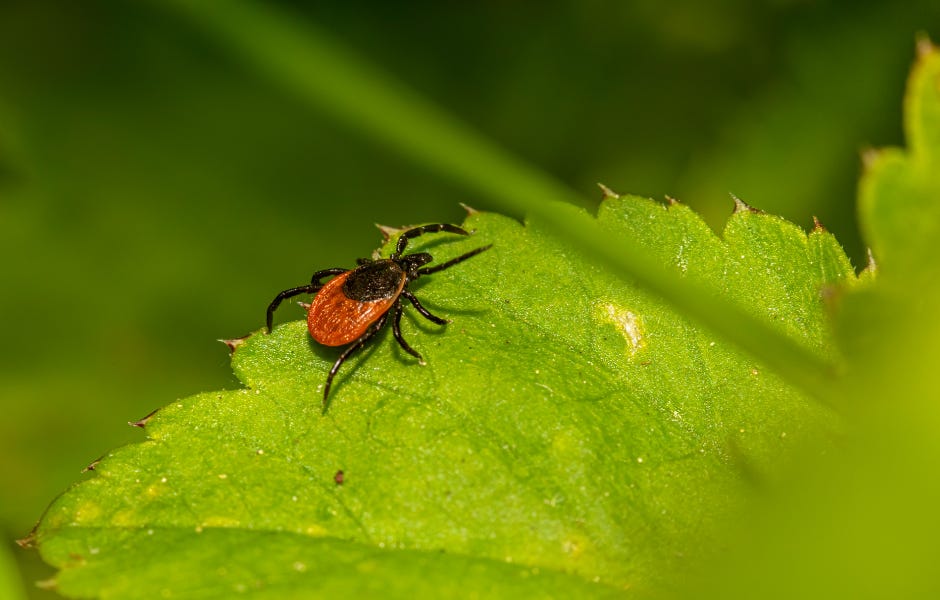Do all celebrities have Lyme disease now?
Spoiler: It’s not ticks in Beverly Hills. It’s fraudulent diagnostics, wellness grifters, and a whole lot of celebrity pseudoscience.
This newsletter is free, but it’s able to sustain itself from support I receive from a small percentage of regular readers. If you value science-based information, consider upgrading to a paid subscription:
Last week, media outlets were awash with headlines about another celebrity revealing a years-long battle with Lyme disease. Justin Timberlake announced on social media that he has been plagued with debilitating nerve pain and fatigue due to Lyme, and was “shocked” by the diagnosis. He shared this to explain why he may have appeared to be struggling during his current tour.
No one wants to feel like that, and with up to 30% of adults experiencing chronic pain or fatigue, I absolutely sympathize with Timberlake and others with medically unexplained symptoms.
The issue? Lyme disease has long been a popular scapegoat among the affluent elite. And it undermines the real science and public health work being done on this infection.
I grew up near Lyme, Connecticut and have lived my entire life in the epicenter—CT, NY, NJ, PA. I studied Lyme disease for my PhD, and even did undergrad research at Stony Brook University. So when I say the celebrity Lyme narrative doesn’t add up—I mean it.
If you’ve noticed that celebrities seem to have an unusually high rate of Lyme, you’re not imagining it. From Avril Lavigne and Justin Bieber to Yolanda and Gigi Hadid, Shania Twain, Alexis Ohanian, and multiple Real Housewives, there’s a steady stream of headlines claiming years-long struggles with Lyme and lingering symptoms. And somehow, they all seem to be among the rare few with long-term complications—called sequelae—which, spoiler, occur in a small minority of real Lyme cases.
For the public, these stories, picked up by almost every media outlet (because a celebrity is involved!) fuel fear and misinformation about a specific, tick-borne illness. So let’s talk about what’s real—and what’s not.
What it actually takes to get Lyme disease
Lyme disease is a bacterial infection spread through the bite of infected ticks—but several very specific conditions must align for that to happen:
The right species of tick (Ixodes scapularis or Ixodes pacificus)
The bacteria (Borrelia burgdorferi) must be present in the environment
The tick must be infected with the bacteria
Natural hosts like white-footed mice and deer must sustain tick populations
The tick must stay attached to a person long enough to transmit the bacteria
The immune system must fail to eliminate the bacteria before infection sets in
If even one of these pieces is missing, Lyme disease doesn’t occur.
That’s why 95% of US Lyme cases occur in just 16 states—in the Northeast and Midwest—where all of these conditions align.
The bacteria that cause Lyme disease—Borrelia burgdorferi spp.—have existed for at least 60,000 years. They naturally infect wild animals that carry them without getting sick. In humans, they can cause disease, but only if delivered by a vector: the bite of an infected tick.
And not just any tick can transmit Lyme. Of nearly 100 tick species in North America, only black-legged ticks (Ixodes scapularis) and western black-legged ticks (Ixodes pacificus) can carry and transmit Borrelia burgdorferi to humans.
These Ixodes ticks are finicky. They need high humidity, dense brush, leaf litter, and shaded woods. They’re not found in deserts, sunny grasslands, or high elevations. They can’t survive where humidity dips below 80% or where temperatures climb above 85°F for extended periods. In short: they don’t do well in arid, sunny places.
Like…Southern California? (that’s where Hollywood is)
Most celebrities live in Southern California—about the worst possible habitat for Ixodes ticks. Los Angeles is semi-arid, with average humidity around 52%. And yes, celebrities travel, the idea that so many of them are frolicking through tick-infested forests in the Northeast and Midwest US often enough to all catch Lyme? The math isn’t mathing.
Ticks don’t just need the right environment—they need food. Specifically, blood. As obligate ectoparasites, they must feed on other animals to survive. Ixodes ticks thrive in the Northeast and Midwest not just for the humidity and leaf litter, but that’s where essential hosts—white-footed mice and white-tailed deer—live. No mice or deer? No ticks. No ticks? No Lyme. Yes, ticks will bite people and pets if we wander into their habitat, but we’re just accidental meals.
White-tailed deer and white-footed mice don’t live everywhere—they have specific habitats too. Combine that with the limited range where Ixodes ticks can survive, and you get the real map of where Lyme disease can actually occur.
The final piece: to get Lyme, a person must be bitten by an infected tick—and it has to stay attached long enough. With Borrelia burgdorferi, transmission is passive and it takes time. The bacteria live in low levels in the tick’s midgut until a blood meal wakes them up. As the tick feeds, the bacteria multiply, overflow into the salivary glands, and enter the host. That whole process takes 24–36 hours. If you remove an attached tick before then, and even if it was the right species and infected, your odds of infection are near zero.
Why do celebrities keep saying they have Lyme?
There’s a major gap between where Lyme actually exists and where the public thinks it does, fueled by social media, celebrity anecdotes, and a wellness industry that profits off Lyme pseudoscience.
Take Justin Timberlake, the topic of recent Lyme disease chatter. He lived in Los Angeles for years and now resides full-time in Big Sky, Montana. Neither place is a Lyme hotspot. He’s also married to Jessica Biel, who has opposed vaccines and other public health policies. One kind of pseudoscience often invites another.
He is not unique in this, either. Many celebrities purportedly diagnosed with Lyme disease live in places like Southern California, where Lyme disease is not prevalent, making their diagnoses even more questionable.
Are we really supposed to believe these celebrities are the rare few who left their Malibu mansions, wandered through tick-infested forests in the Northeast, and got infected?
I’ve dragged tick sheets through tall grass in New York for research. I’ve lived in the epicenter of Lyme for 38 years. I’ve still never gotten Lyme. So… no, I don’t buy it.
What is happening with Timberlake and other celebrities? That’s where the pseudoscience comes in.
The symptom trap
Lyme disease presents with vague, non-specific symptoms like fatigue, joint pain, and occasional neurological issues that overlap with dozens of other conditions, making accurate diagnosis tricky. While the hallmark bull’s-eye rash (called erythema migrans) is a clear diagnostic, it’s not always noticed even though it is present in 60-80% of cases. The remaining symptoms of Lyme are nonspecific and shared with many conditions:
Multiple Sclerosis is an autoimmune disorder that can cause neurological symptoms that mimic neurological Lyme, which only occurs in ~10% of real cases.
Rheumatoid Arthritis (RA) causes joint pain, swelling, fatigue, and body aches, all symptoms that can resemble Lyme arthritis, a late-stage presentation seen in ~20% of Lyme cases.
Lupus (Systemic Lupus Erythematosus, SLE) presents with fatigue, joint pain, rash, and fever—all shared with Lyme.
Other Tick-borne Illnesses: like anaplasmosis, ehrlichiosis, and babesiosis are caused by different pathogens but share symptoms with Lyme disease, including fever, fatigue, headache, muscle pain, and joint aches.
Mononucleosis (caused by infection with the Epstein-Barr virus) causes fatigue, fever, sore throat, and swollen lymph nodes—again, easily confused with Lyme.
Bell’s Palsy (often viral, like from Varicella zoster virus) causes facial paralysis and drooping. Neurological Lyme can do the same, but again, that’s a minority of cases.
Mental health issues like depression and anxiety can cause fatigue, cognitive issues, sleep disturbances, tremors, palpitations, and general feelings of malaise. See the pattern?
Cognitive and endocrine disorders like hypothyroidism can also cause memory problems, brain fog, and low energy—sound familiar?
Many of these conditions lack definitive tests—so it’s easy for vague symptoms to get misattributed, especially when someone’s already primed to blame Lyme.
The celebrity wellness Lyme trap
Lyme has become a trendy diagnosis among celebrities—even when it’s wrong. Why? Because it’s a tidy, external explanation. A tick bite sounds better than anxiety, autoimmune disease, or burnout. It’s tangible. It’s less stigmatized.
And celebrities have what the pseudoscience industry thrives on: money, visibility, and access to unqualified practitioners. They’re under pressure to explain chronic symptoms—and there’s always someone ready to sell them an answer. They’re constantly under pressure to perform and explain vague, persistent symptoms. And in that sense, they’re exploited too: a cash cow for alternative practitioners who reject established medical guidelines and peddle unproven, often dangerous tests and treatments.
So yes, I feel for them. But let’s be clear—they’re also amplifying misinformation that harms the public.
Celebrity endorsements of Lyme as a chronic and incurable illness have fueled a lucrative pseudoscience market offering fake “cures”: IV vitamin cocktails, hyperbaric oxygen, ozone therapy, expensive supplements, long-term antibiotic treatments via PICC lines, chelation treatments, urine therapy, and more. None of it is backed by credible science. Much of it is actively harmful.
These treatments aren’t just ineffective; they’re predatory and dangerous. Clinics run by unqualified practitioners target affluent patients, including celebrities, and sell them expensive regimens with zero scientific basis. The harms of these interventions have been detailed for a long time.
When a celebrity gets sick, the world watches. With excess money and time, it’s easy to chase a diagnosis—especially one that sounds tidy, external, and curable. Fatigue, headaches, muscle aches? Those symptoms are everywhere. Lyme just makes a convenient scapegoat.
Why is Lyme such a popular scapegoat? It’s a definitive diagnosis, caused by an external source—a tick bite—and it’s gained pop-culture attention as a “trendy” illness. Unlike mental health conditions or other complex medical conditions, it is tangible and less stigmatized.
Another driver: Lyme is a popular label to slap on people among practitioners with no infectious disease expertise—naturopaths, homeopaths, chiropractors, and MDs trained in completely unrelated fields. They’re especially popular in celebrity circles, where money is no object and “vibes over science” is their wellness mantra. And yes, these providers claim to be Lyme experts, pushing long-term, ineffective, and risky treatments (while profiting) even when there is no clinical or epidemiological evidence of Lyme.
Worse, the treatments they prescribe are based on fraudulent diagnostics—tests that are not FDA-approved, not scientifically valid, and not endorsed by any infectious disease experts. Yet celebrities promote them because the same practitioners pushing the tests also profit from the treatments. (read more in the below):
Lyme Disease: fraudulent tests are rampant
While Lyme disease is a public health concern, rampant misinformation has led many in the general population to perceive it as a much bigger threat than it is.
I’ve written about this extensively—including Bella Hadid’s use of such tests. It’s a case study in how celebrity pseudoscience undermines public health.
Chronic Lyme Disease: fake diagnosis, but it's more complicated
“Although Lyme disease is a public health concern, extensive publicity has resulted in a degree of anxiety about Lyme disease that is out of proportion to the actual morbidity that it causes.”
The real harm of celebrity amplification of Lyme pseudoscience
This misinformation ecosystem means that Lyme disease is frequently over-diagnosed by practitioners who are not qualified to do so using fraudulent tests, or even self-diagnosed by celebrities or other individuals who fall prey to misinformation shared by celebrities and media outlets who platform them.
Yes, Lyme disease is real. Yes, it can be serious. Yes, it's the most common vector-borne disease in the US, so it is not unexpected that some celebrities would contract it. But media hype around celebrity cases obscures the truth.
Too many of these stories involve people who claim they got Lyme in places where it doesn’t exist (like Australia), don’t live in regions where Lyme exists, don’t spend time in tick habitats, and have no evidence of a tick bite. Many have publicly stated they relied on fake tests (by companies like IgeneX) or alternative practitioners. This fuels confusion, encourages overdiagnosis, and misdirects funding.
Meanwhile, real physicians and researchers are sidelined by celebrity-backed misinformation machines.
Lyme disease has been the victim of a profitable wellness industry complex for decades: patient ‘advocacy’ groups get celebrities (like Christopher Meloni and the Hadid’s) to serve as influencers and donors under the guise of public health. These influencer-fueled groups partner with self-proclaimed “Lyme specialists”—often chiropractors, naturopaths, or MDs in irrelevant fields (like psychiatry)—who pay for referrals, push bogus diagnostics, and sell dangerous treatments.
It’s a whole ecosystem. And it’s profitable, media-friendly, and deeply harmful.
Celebrity attention doesn’t bring awareness to a misunderstood illness: it legitimizes dangerous misinformation.
Sensational media coverage of a celebrity revealing a Lyme diagnosis creates an environment where even more people seek diagnoses and treatments based on fear rather than facts. That’s in large part because media outlets will cover the story without an ounce of critical assessment of the claims or the science. This is literally happening since Justin Timberlake posted on social media.
Lyme disease is a real condition and a public health concern. But this constant celebrity promotion and media attention of Lyme pseudoscience harms the credible research and clinical work on Lyme.
The Lyme pseudoscience industry has been the model for other pseudoscience industries. It is profitable, legitimized by media attention, and actively attacks the science-based world of the illness.
Science matters. Celebrity shouldn’t.
Lyme disease prevalence is increasing due to expanding tick habitats, primarily driven by reforestation, habitat fragmentation, and suburbanization (not climate change).
Preventing tick bites matter: tick checks, effective insect repellents, appropriate clothing, risk awareness.
Quality research on Lyme also matters: it’s how we develop new diagnostics, develop a replacement vaccine, improve understanding of the complex enzootic life cycle of ticks and the bacteria, and change clinical treatment guidelines.
But giving a megaphone to celebrity-driven conspiracies about Lyme, whether it be about debunked persistent infections or bioweapons engineering of the bacteria, is not helpful. In fact, its actively dangerous.
If celebrities want to help raise real awareness? Great.
But when they promote myths, fuel pseudoscientific markets, and mislead the public, that’s a problem. Media outlets that amplify their claims, especially without an ounce of due diligence, are complicit.
This isn’t just about one celebrity. It’s about a culture that puts vibes over science, influencers over evidence, and feelings over facts.
The rest of us? We’ve got to push back against disinformation in all forms, including about Lyme disease.
A note: I volunteer as the Executive Director of the American Lyme Disease Foundation, a non-profit formed in the 1990s. ALDF consists of infectious disease physicians and scientists expert in tick ecology and biology, bacteriology, and immunology.
ALDF aims to provide accurate information for the public about Lyme and tick-borne illnesses. With pseudoscience patient ‘advocacy’ organizations that get a lot of money from celebrity donations, that work is more important than ever. ALDF is sustained solely on donations, so if you want to support credible Lyme science, we welcome that!






I don’t get it. I’m not talking about this piece written here—it’s thoroughly informative and concise. What I don’t understand is WHY is this the celebrity disease du jour. To me, Lyme Disease seems like one of the easiest to cross off the list because it has such specific conditions. Then again, I don’t understand why people take vaccine advice from a chiropractor. So maybe it’s just me…I just don’t get it.
Hi Dr Love . Primary doc since 1986 here. Working the whole time in central Maryland . Managed lots of Lyme. It is tricky and one does have to keep alert about it. But I sensed in the 90s that something was afoot about overuse or frank abuse of the diagnosis . Your writing on Lyme is why I subscribed. Thanks for this. Don’t get me started on “Lyme Literate “ docs. And you mentioned drivers of the problem - I cringe or sigh with every time I have to deal with a random IgM Lyme that someone has ordered - if not ordered in the first 6 weeks after a deer tick bite of significant duration , I believe the PPV is under 5%. Thanks again for your work .